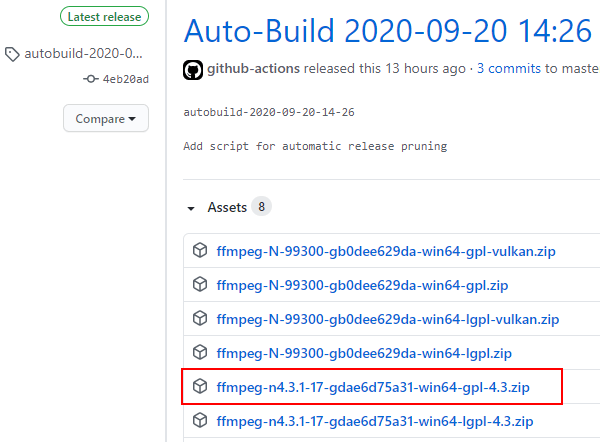

- #HOW TO INSTALL FFMPEG WINDOWS 7 HOW TO#
- #HOW TO INSTALL FFMPEG WINDOWS 7 ZIP FILE#
- #HOW TO INSTALL FFMPEG WINDOWS 7 FULL#
- #HOW TO INSTALL FFMPEG WINDOWS 7 WINDOWS 10#

All builds are 64-bit.īecause ffmpeg is built for 64-bit only, this installer is 64-bit only. If you're downloading ffmpeg to support features in a program such as Krita or Blender, get the release essentials build. They may work on Windows Vista but that hasn't been tested. These are compatible with Windows 7 and above. hosts packages containing binaries of ffmpeg, ffprobe and ffplay. Gyan makes a few notes regarding these builds: Rather than compile my own ffmpeg build I opted to use one that is already available. No tampering or modification has occured. The build contained in this installer is obtained from gyan. For use refer to the official documentation. Aboutįfmpeg is an open source command line multimedia framework to encode, decode, transcode, convert etc. If all goes well, you should see details about FFmpeg like version number, default configuration, etc.Ease-of-use binary executable installers for Windows 7 and up (64bit/圆4). To check if FFmpeg is properly added to the Windows path, open a Command Prompt or PowerShell window, type ffmpeg and press Enter. Note : If you have saved FFmpeg in another directory, please change the path accordingly. Each path you add to the value field should be separated by a sign. Go to the end of the line in the Variable Value field and add C:ffmpegbin. In the System Variables section, find the Path variableĤ. In the System Variables section, find the Path variable, select it, and click the Edit button. Next, go to the Advanced tab and click the Environment Variables button. Open the Start menu, search for "Edit System Environment Variables" and click on the result.Ģ.
#HOW TO INSTALL FFMPEG WINDOWS 7 WINDOWS 10#
The process of adding FFmpeg to the Windows 7 path is similar to that of Windows 10 but the user interface is a bit different.ġ. Add FFmpeg to the path of Windows 7 or Windows 8 Interface in the main Environment Variables windowġ0. This is the interface in the main Environment Variables window. Note : If you have placed the FFmpeg folder in another directory or drive, change the directory path accordingly.ĩ. In the blank field, enter C: ffmpegbin and click the OK button. Select the Path variable and click Edit.Ĩ. Go to the Advanced tab and click the Environment Variables button. The System Properties window will open.ĥ. To add FFmpeg to the Windows 10 path, search for "Edit the system environment variables" in the Start menu and click on the result. Renaming is optional but will make it easier when you add it to the Windows path.Ĥ. In the example case, the author extracted it to the root directory of drive C.ģ.
#HOW TO INSTALL FFMPEG WINDOWS 7 ZIP FILE#
After downloading, extract the contents of the ZIP file into the directory of your choice. To get started, visit the official website and download the current stable build of FFmpeg.Ģ. Once added, you can access FFmpeg via Command Prompt or PowerShell from any folder. To solve that problem, you must add FFmpeg to the Windows 10 path with an environment variable. This is not a big deal, but it is not very user friendly. However, you must manually navigate to the FFmpeg folder in the Command Prompt to access the ffmpeg.exe file and execute the relevant commands. In theory, since it's a portable software, you don't need to install FFmpeg to use it.
#HOW TO INSTALL FFMPEG WINDOWS 7 HOW TO#
In this quick guide, shows you how to download and install FFmpeg properly in Windows 10, 8 and 7. In short, FFmpeg is great and every user should install FFmpeg in Windows. The best thing about FFmpeg is that you can do most of these with commands. You can use FFmpeg to convert video and audio files, split audio files, download HLS streaming videos, etc. Below is a step by step guide to install FFmpeg properly in Windows, add FFmpeg to the Windows path and verify FFmpeg installation.įFmpeg is one of the most popular, free and open source software for encoding and decoding multimedia.


 0 kommentar(er)
0 kommentar(er)
